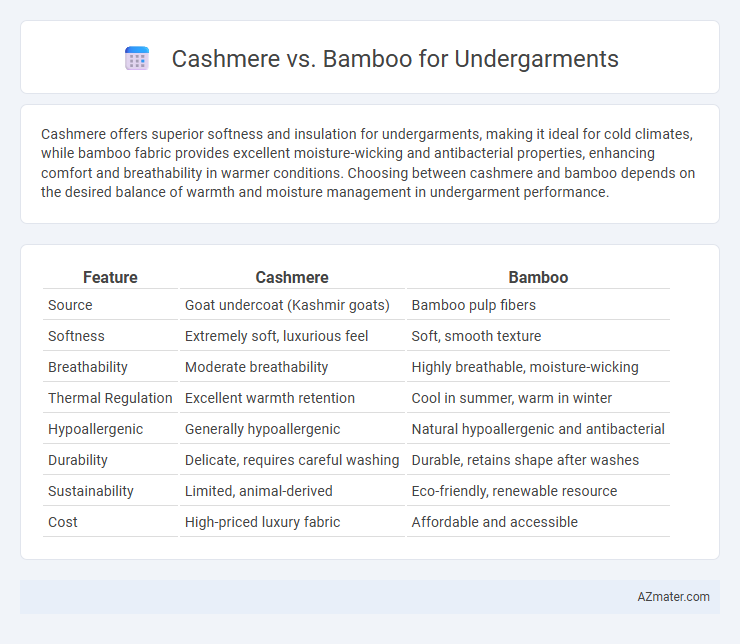Cashmere offers superior softness and insulation for undergarments, making it ideal for cold climates, while bamboo fabric provides excellent moisture-wicking and antibacterial properties, enhancing comfort and breathability in warmer conditions. Choosing between cashmere and bamboo depends on the desired balance of warmth and moisture management in undergarment performance.
Table of Comparison
| Feature | Cashmere | Bamboo |
|---|---|---|
| Source | Goat undercoat (Kashmir goats) | Bamboo pulp fibers |
| Softness | Extremely soft, luxurious feel | Soft, smooth texture |
| Breathability | Moderate breathability | Highly breathable, moisture-wicking |
| Thermal Regulation | Excellent warmth retention | Cool in summer, warm in winter |
| Hypoallergenic | Generally hypoallergenic | Natural hypoallergenic and antibacterial |
| Durability | Delicate, requires careful washing | Durable, retains shape after washes |
| Sustainability | Limited, animal-derived | Eco-friendly, renewable resource |
| Cost | High-priced luxury fabric | Affordable and accessible |
Introduction to Cashmere and Bamboo Undergarments
Cashmere undergarments are crafted from the soft, insulating fibers of the cashmere goat, offering exceptional warmth, breathability, and a luxurious texture ideal for cold climates. Bamboo undergarments utilize eco-friendly, hypoallergenic fibers derived from bamboo plants, known for moisture-wicking properties and natural antimicrobial benefits that enhance comfort and hygiene. Both materials provide unique advantages, with cashmere excelling in warmth and softness, while bamboo focuses on sustainability and moisture management.
Origins and Production Processes
Cashmere originates from the soft undercoat of Cashmere goats primarily raised in the mountainous regions of Mongolia, China, and Nepal, where fibers are meticulously hand-combed during the molting season. Bamboo fabric is derived from the cellulose of bamboo grass, processed through mechanical crushing or chemical treatments like the viscose method to create soft, breathable fibers. The production of cashmere is labor-intensive and limited by seasonal yield, whereas bamboo fabric production involves large-scale industrial processes with varied ecological impacts depending on the methods used.
Texture and Comfort Comparison
Cashmere offers an ultra-soft, luxurious texture that feels warm and cozy against the skin, making it ideal for undergarments in cooler climates. Bamboo fabric provides a smooth, breathable, and moisture-wicking texture that enhances comfort by regulating temperature and reducing irritation. Both materials deliver exceptional softness, but bamboo's natural antibacterial properties and superior breathability make it more suitable for all-day wear in warmer conditions.
Breathability and Moisture-Wicking Abilities
Cashmere offers moderate breathability with natural temperature regulation, making it soft and warm but less effective in moisture-wicking compared to bamboo. Bamboo fibers excel in breathability and moisture-wicking abilities, quickly drawing sweat away from the skin to keep undergarments dry and comfortable. The combination of antimicrobial properties and superior moisture management makes bamboo ideal for activewear undergarments, while cashmere suits cooler, low-activity conditions.
Temperature Regulation: Warmth vs Coolness
Cashmere offers superior warmth by trapping heat with its fine, insulating fibers, making it ideal for cold-weather undergarments. Bamboo fabric excels in moisture-wicking and breathability, providing a cooling effect that helps regulate body temperature in warmer climates. Choosing between cashmere and bamboo depends on desired thermal comfort, with cashmere favoring warmth and bamboo optimizing coolness and dryness.
Durability and Longevity
Cashmere undergarments offer exceptional softness but require careful maintenance to preserve their delicate fibers, as they can pill or weaken with frequent washing, affecting durability. Bamboo fabric, known for its natural strength and moisture-wicking properties, provides greater resistance to wear and tear, extending the longevity of undergarments through regular use. Choosing bamboo over cashmere ensures more durable undergarments that maintain shape and comfort over time without extensive care requirements.
Hypoallergenic Properties and Skin Sensitivity
Cashmere offers natural hypoallergenic properties due to its fine, breathable fibers that minimize irritation and wick moisture effectively, making it suitable for sensitive skin. Bamboo fabric contains antibacterial and antimicrobial qualities inherent in its cellulose fibers, which help reduce allergens and prevent skin infections. Both materials provide soft, non-irritating undergarments, but bamboo's moisture-wicking ability often better supports individuals prone to skin sensitivities and allergies.
Eco-Friendliness and Sustainability
Cashmere and bamboo differ significantly in eco-friendliness and sustainability, with bamboo being a rapidly renewable resource requiring less water and pesticides compared to cashmere, which involves intensive grazing often leading to land degradation and biodiversity loss. Bamboo undergarments benefit from natural biodegradability and a smaller carbon footprint, while cashmere production's environmental impact is higher due to methane emissions from goats and slower fiber regeneration. Sustainable bamboo farming paired with eco-friendly processing methods offers a more environmentally responsible choice for undergarments than traditional cashmere sourcing.
Care and Maintenance Requirements
Cashmere undergarments require gentle hand washing with cold water and specialized wool detergents to prevent fiber damage and maintain softness. Bamboo fabric offers easier care, often machine washable on gentle cycles and quick drying due to its moisture-wicking properties. Both materials benefit from air drying and avoiding high heat to preserve fabric integrity and extend garment lifespan.
Price Points and Value for Money
Cashmere undergarments typically command higher price points due to the luxury fiber's softness, warmth, and durability, making them a premium investment for those seeking superior comfort and insulation. Bamboo undergarments offer excellent value for money, providing natural moisture-wicking, breathability, and antibacterial properties at more affordable prices. The choice between cashmere and bamboo undergarments hinges on balancing budget constraints with desired performance features, where bamboo excels in everyday practicality and cashmere delivers unmatched luxury.

Infographic: Cashmere vs Bamboo for Undergarment
 azmater.com
azmater.com